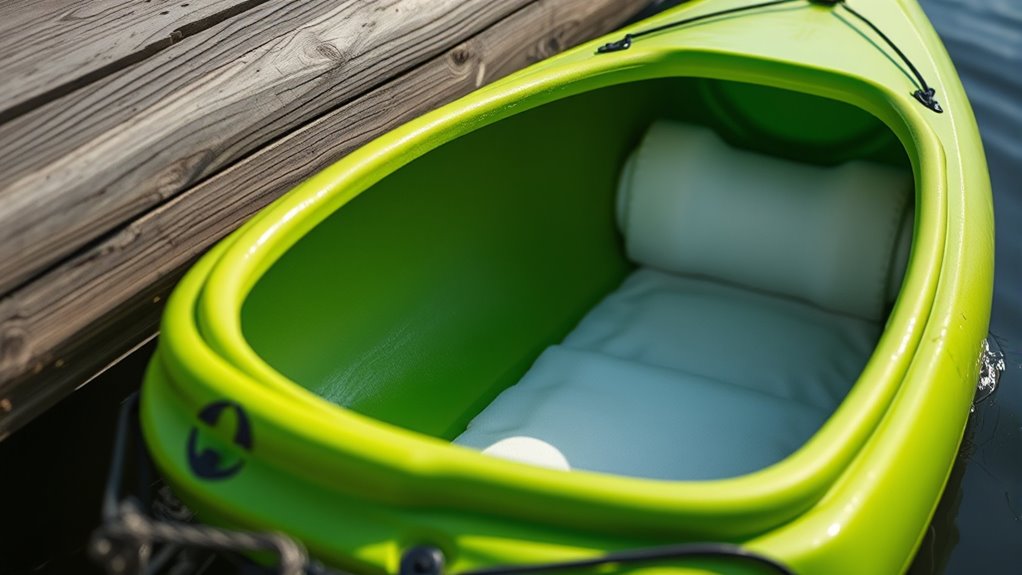To prevent flooding in your sea kayak, regularly inspect the bulkhead for cracks, dents, or leaks. Clean the area thoroughly and reapply marine-grade sealant on seams, joints, and fasteners to maintain a watertight seal. Check the hull for damage and address issues promptly. Consistent maintenance helps extend the life of your bulkhead and keeps your kayak safe and dry. If you want detailed tips, keep going for more useful advice.
Key Takeaways
- Regularly inspect the bulkhead and surrounding seams for cracks, dents, or damage to catch issues early.
- Clean the area thoroughly before resealing, removing dirt, old sealant, and contaminants.
- Reapply marine-grade sealant along seams, joints, and fasteners to maintain watertight integrity.
- Check and tighten bolts or fasteners periodically to prevent water intrusion through gaps.
- Follow manufacturer’s curing instructions and perform routine inspections to ensure ongoing waterproof protection.

Maintaining your sea kayak’s bulkhead is essential to make certain its structural integrity and safety on the water. The bulkhead acts as a barrier that prevents water from flooding the main compartment, so keeping it in top condition is crucial. Regular hull inspection is the first step in this process. When inspecting the hull, look for cracks, dents, or any signs of damage that could compromise the bulkhead’s seal. Pay close attention to seams and joints, as these are common weak points that can develop leaks over time. If you notice any issues, address them promptly to prevent water intrusion during your trips. Additionally, understanding the best maintenance practices can extend the life of your kayak’s bulkhead and ensure safety. Sealant application plays a vital role in maintaining the bulkhead’s effectiveness. Over time, sealants can degrade due to exposure to sun, saltwater, and temperature changes. Reapplying sealant ensures that the bulkhead remains watertight. To do this properly, you should first clean the area thoroughly, removing any dirt, old sealant, or debris. Use a gentle solvent if necessary, but avoid harsh chemicals that could damage the material. Once the surface is clean and dry, apply a marine-grade sealant specifically designed for kayak hulls. Use a steady hand to create a continuous, even bead along the seams and around any bolts or fasteners. Make sure to follow the manufacturer’s instructions regarding curing time so the sealant fully bonds and provides a reliable barrier against water.
Frequently Asked Questions
How Often Should Bulkheads Be Inspected for Damage?
You should perform a bulkhead inspection at least once every season to guarantee damage prevention. Regular inspections help you spot cracks, leaks, or other damage early, preventing potential flooding. After each trip, especially if you’ve encountered rough conditions, check for any signs of wear. Maintaining a consistent inspection routine keeps your kayak in top shape, reducing the risk of flooding and prolonging its lifespan.
What Tools Are Recommended for Bulkhead Repairs?
When repairing your bulkhead, you should have a tools checklist ready, including sealant, epoxy, sandpaper, and a putty knife. Use repair techniques like cleaning the damaged area thoroughly before applying sealant or epoxy to guarantee a watertight seal. A screwdriver and scissors are also handy for adjusting or trimming materials. Proper tools and techniques help you effectively maintain your bulkhead, preventing leaks and ensuring your kayak stays dry during trips.
Can Bulkhead Maintenance Be Performed DIY?
You can definitely perform DIY inspection and bulkhead replacement if you’re comfortable with basic repairs. Start by inspecting your bulkhead regularly for cracks or leaks, then gather suitable tools like sealant and replacement panels. Follow step-by-step guides to remove damaged sections and install new ones properly. Just make certain you work carefully, prioritize safety, and have some repair experience to avoid causing further damage or flooding.
What Are Signs of a Failing Bulkhead?
Ever wonder if your bulkhead’s about to fail? Signs appear when material degradation causes cracks or brittleness, and sealing integrity diminishes, risking leaks. You might notice water seepage, unexplained dampness, or a sudden loss of buoyancy. Don’t ignore these warning signs. Regular inspections help catch issues early, ensuring your kayak stays watertight. Addressing minor problems promptly can save you from major repairs—or worse, a flooded kayak on your next adventure.
Are Aftermarket Bulkhead Upgrades Available?
You can find aftermarket bulkhead options made from various materials like reinforced plastic, foam, or composite materials. These upgrades are designed to enhance durability and prevent leaks. When considering aftermarket bulkhead materials, look for options that fit your kayak’s specific model and provide a watertight seal. Upgrading your bulkhead with reliable aftermarket options can improve safety and extend your kayak’s lifespan, ensuring you stay dry on your adventures.
Conclusion
By keeping your bulkhead sealed tight, you’re the guardian of your kayak’s fortress, preventing water from sneaking in like a silent thief. Regular maintenance is your shield, turning potential floods into calm, still waters. Think of it as tuning a delicate instrument—when you care for it, it sings in harmony. Stay vigilant, and your kayak will be ready to dance with the waves, keeping you safe and dry on every adventure’s horizon.










